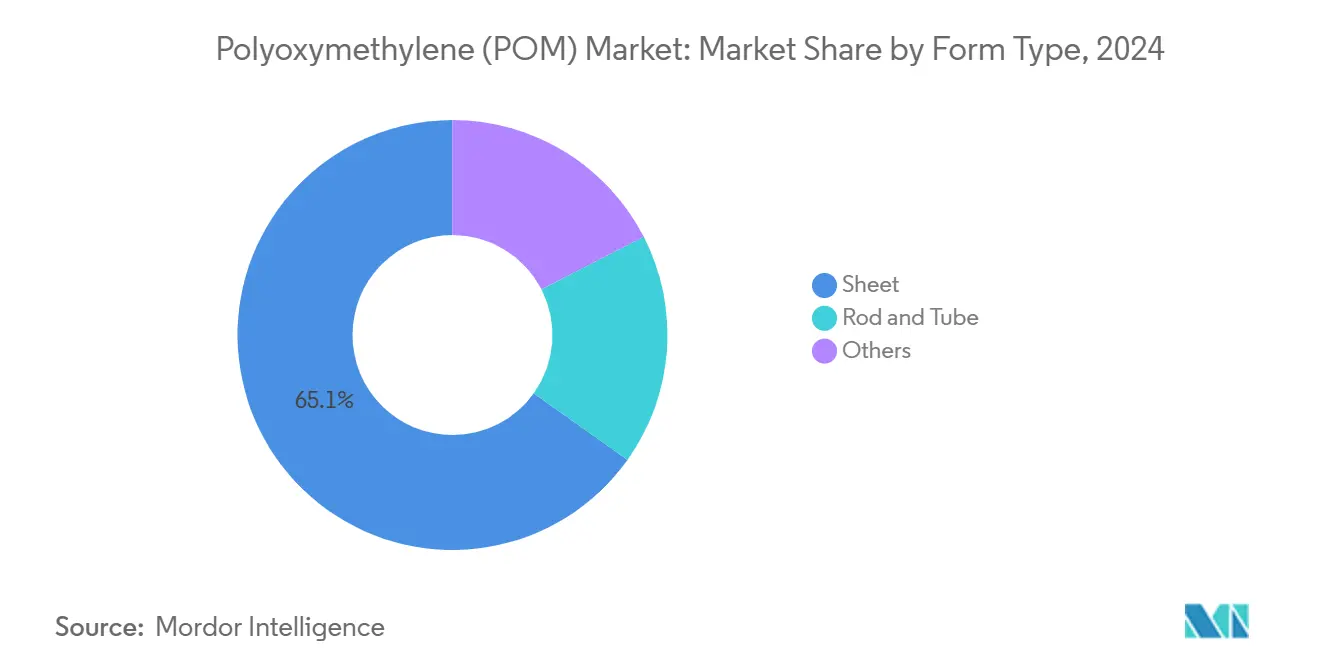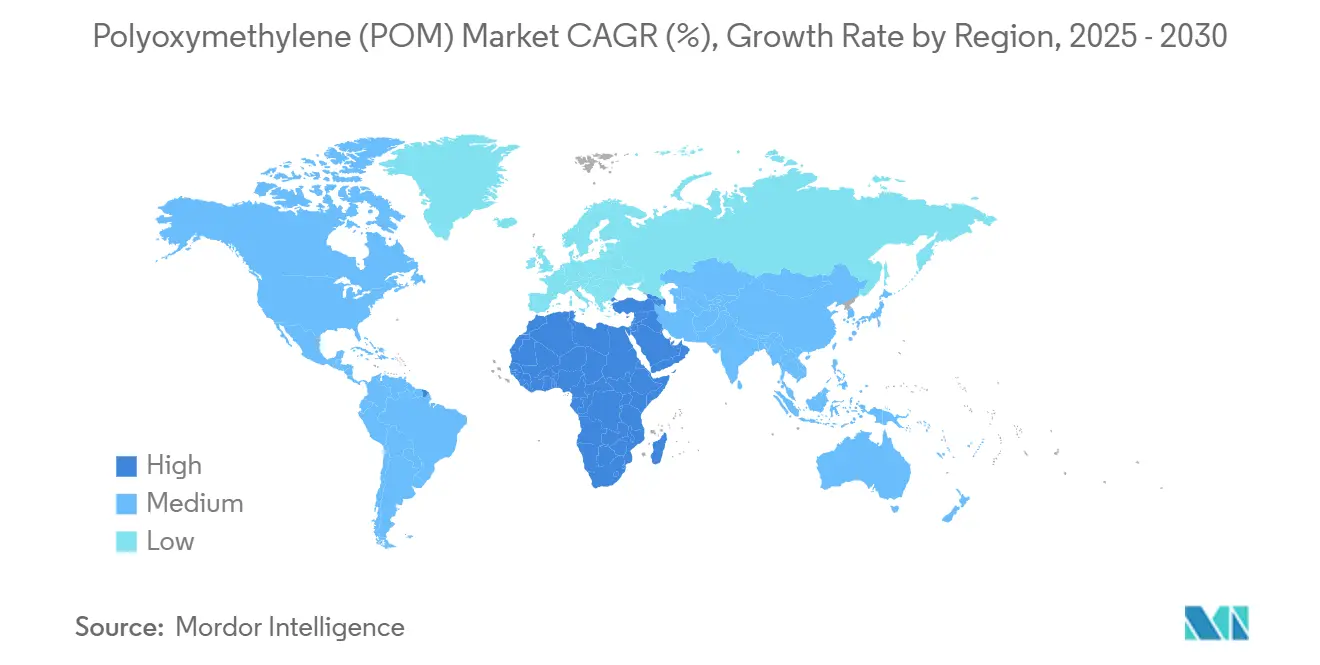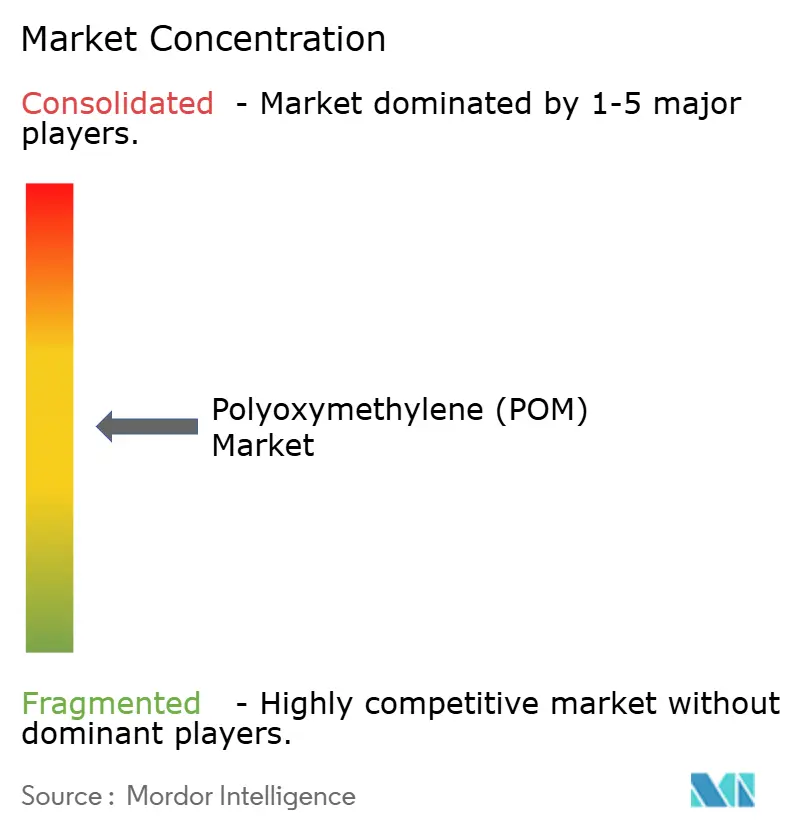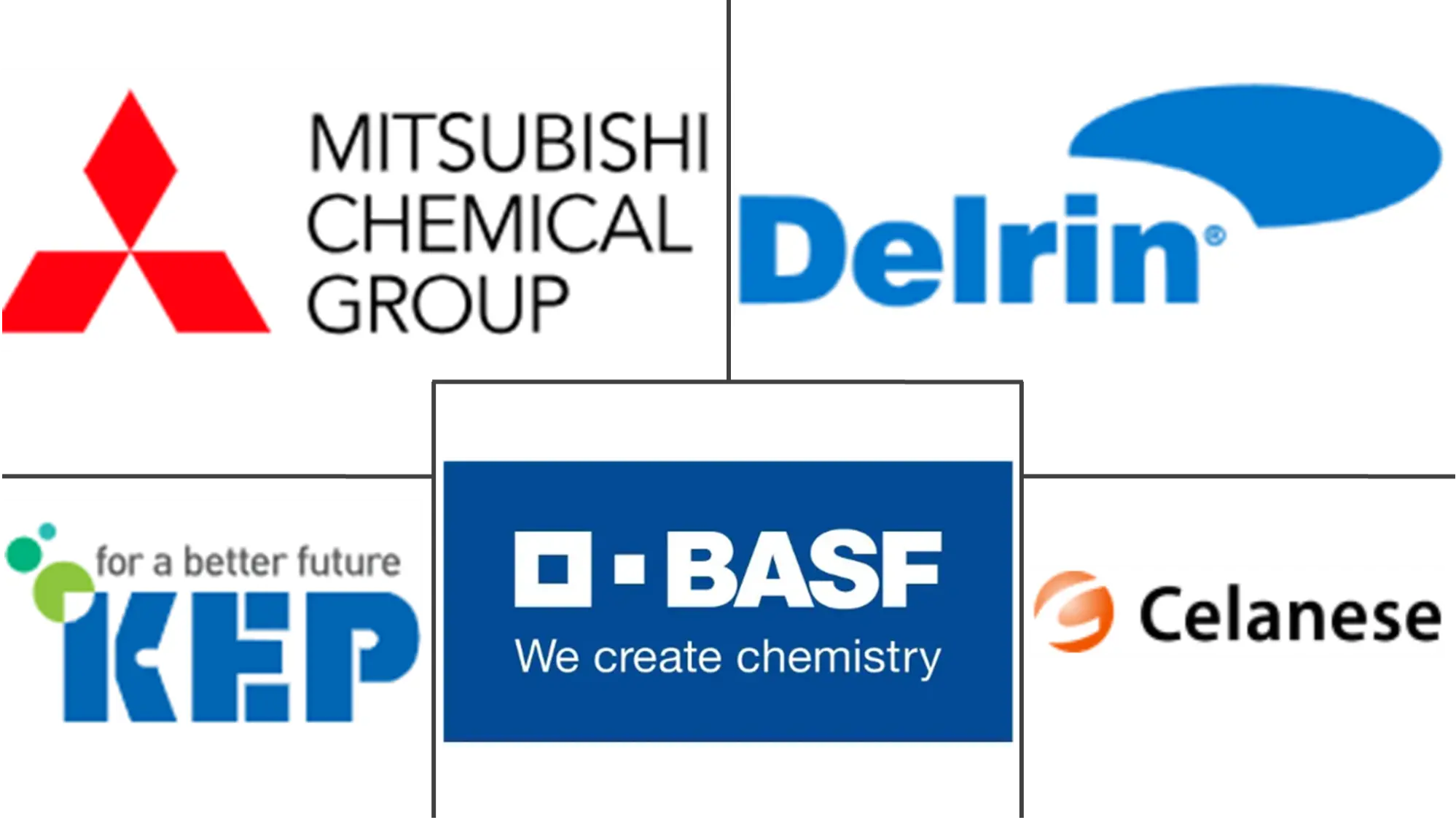Polyoxymethylene (POM) Market Size and Share

Polyoxymethylene (POM) Market Analysis by Mordor Intelligence
The Polyoxymethylene Market size is estimated at 1.72 million tons in 2025, and is expected to reach 2.18 million tons by 2030, at a CAGR of 4.77% during the forecast period (2025-2030). Elevated demand stems from automotive lightweighting programs, electronics miniaturization, and the shift from metal to plastic in precision machinery. The implementation of tighter vehicle emission rules in the European Union, China, and the United States favors the broader adoption of dimensionally stable engineering resins. Original equipment manufacturers (OEMs) are designing single-material modules to reduce part counts and simplify recycling, an approach that reinforces the selection of acetal copolymers. Meanwhile, sustainability initiatives encourage producers to launch low-formaldehyde and recycled-content grades that meet regulatory thresholds without sacrificing mechanical integrity. On the competitive front, integrated Asian producers leverage captive methanol supply and proximity to downstream converters to reinforce cost advantages, while Western suppliers differentiate through specialty formulations aimed at electric vehicle (EV) interiors and semiconductor tooling.
Key Report Takeaways
- By form type, sheet captured 65.12% of the polyoxymethylene market share in 2024. The sheet segment is projected to expand at a 5.14% CAGR through 2030.
- By end-user industry, automotive held 31.05% of the polyoxymethylene market size in 2024. Aerospace is advancing at a 5.81% CAGR between 2025 and 2030.
- By geography, Asia-Pacific accounted for 67.21% of the polyoxymethylene market share in 2024. The Middle-East and Africa are forecast to register a 6.08% CAGR through 2030.
Global Polyoxymethylene (POM) Market Trends and Insights
Drivers Impact Analysis
| Drivers | (~) % Impact on CAGR Forecast | Geographic Relevance | Impact Timeline |
|---|---|---|---|
| Automotive lightweighting boom | +1.2% | Global, led by Asia-Pacific | Medium term (2-4 years) |
| Miniaturization in electrical and electronics | +0.9% | Asia-Pacific core, spill-over to North America and Europe | Short term (≤ 2 years) |
| Metal-to-plastic shift in industrial machinery | +0.8% | Global, early gains in Germany, Japan, China | Long term (≥ 4 years) |
| Manufacturing expansion in Asia-Pacific | +1.1% | Asia-Pacific core, secondary influence on Middle East | Medium term (2-4 years) |
| Low-VOC POM grades for EV interiors | +0.7% | Global, driven by EU and Chinese regulations | Short term (≤ 2 years) |
| Source: Mordor Intelligence | |||
Automotive Lightweighting Boom
Carmakers specify acetal copolymers to reduce vehicle mass while retaining structural stiffness, particularly in fuel modules, door latches, and transmission components. The average automobile incorporated 8–10 lb of POM in 2024, a figure that increases with every new battery-electric model[1]American Chemistry Council, “2024 Chemical Industry Situation and Outlook,” . EV thermal-management systems enhance the resin’s creep resistance and chemical inertness, allowing for thinner-walled parts that withstand under-hood heat cycling. Sliding assemblies, such as window regulators, adopt POM gears to meet lifetime noise, vibration, and harshness (NVH) targets. Automakers also bundle several sub-functions—such as guide rails, seals, and hinge pins—into single, injection-molded modules, maximizing weight savings while simplifying end-of-life disassembly. The 31.05% slice of 2024 demand tied to automotive underlines the polymer’s entrenched role in next-generation mobility solutions.
Miniaturization in Electrical and Electronics
Component scaling in smartphones, wearables, and 5G infrastructure intensifies demand for dimensionally stable plastics that hold micron-level tolerances. POM’s low moisture uptake prevents swelling in humid environments, safeguarding precision in fine-pitch connectors and micro-gears. Static-dissipative grades mitigate electrostatic discharge risks in chip-handling fixtures, while high-flow variants enable thin-wall molding down to 0.25 mm for camera modules. Consumer device makers capitalize on the resin’s easy machinability to rapidly prototype new actuator designs, thereby shortening the time-to-market. The surge of IoT nodes—each requiring dozens of miniature moving parts—further broadens the addressable base for acetal copolymers across Asia-Pacific contract manufacturing hubs.
Metal-to-Plastic Shift in Industrial Machinery
Plant operators replace stainless-steel wear components with acetal shapes to reduce maintenance and eliminate the need for external lubrication. Food processors value FDA-approved and metal-detectable POM, which lowers contamination risk while running quietly on conveyor lines. Precision-ground rods serve as linear bearings in packaging robots, tolerating repetitive load cycles without brinelling. Chemical-processing OEMs adopt the polymer for pump impellers where resistance to weak acids and bases extends service intervals. Energy-efficient factory designs emphasize lighter moving masses, and POM’s density—roughly one-seventh of steel—meets this goal without requiring structural redesign. Strict hygiene protocols in pharmaceutical filling systems also favor the material’s inherent cleanability and low extractables.
Manufacturing Expansion in Asia-Pacific
In early 2024, China launched large-scale projects, which significantly increased regional acetal capacity. This move not only diminished import reliance but also stabilized supply for local converters. Vertical integration into methanol and formaldehyde secures feedstock at a competitive cost, insulating Asian producers from external volatility. Simultaneously, vehicle assembly lines in India, Indonesia, and Vietnam are experiencing escalating call-offs for fuel-system components, seat adjusters, and dashboard mechanisms molded from POM. The growth of the electronics cluster in Guangdong and Penang compounds resin pull as contract manufacturers seek local supply to minimize inventory days. The co-location of feedstock, resin, and part fabrication creates a virtuous cycle that underpins Asia-Pacific’s 67.21% domination of global offtake.
Restraints Impact Analysis
| Restraints | (~) % Impact on CAGR Forecast | Geographic Relevance | Impact Timeline |
|---|---|---|---|
| Competition from Bio-based and High-performance Plastics | -0.8% | Global, with EU leading bio-based adoption | Medium term (2-4 years) |
| Raw-material Price Volatility and Trade Barriers | -1.1% | Global, with APAC supply chains most affected | Short term (≤ 2 years) |
| Methanol Diversion to SAF Value-chain | -0.4% | North America and EU primarily | Long term (≥ 4 years) |
| Source: Mordor Intelligence | |||
Competition from Bio-based and High-Performance Plastics
Sustainability goals prompt OEMs to experiment with cellulose-reinforced acetal and fully bio-derived polyamides, which reduce life-cycle emissions by double-digit percentages[2]Nature Sustainability, “Performance Polyamides Built on a Sustainable Carbohydrate Core,” nature.com. Aerospace suppliers are weighing the substitution of polyetheretherketone (PEEK) for hot-section parts operating above POM’s 100 °C ceiling, despite the associated cost premium. In European consumer goods markets, regulators reward carbon-negative formulations through lower eco-taxes, thereby tilting sourcing decisions. Some medical-device firms are pivoting to sterilization-stable chemistries to withstand repeated steam cycles, thereby eroding the share of POM in precision pump components. Although the incumbent polymer retains a cost-performance sweet spot, rising environmental disclosure obligations threaten demand in applications where drop-in greener alternatives exist.
Raw-Material Price Volatility and Trade Barriers
Methanol spot prices swung on several occasions in 2024, steering POM contract negotiations upward as producers sought margin recovery. Concurrently, China imposed anti-dumping duties on copolymer imports from the United States, the European Union, Japan, and Taiwan, redirecting global trade flows and tightening supply in smaller Asian economies. Producers without backward integration scrambled to secure feedstock, adding inventory costs that squeezed profitability. Some buyers responded by dual-sourcing polyamide or polypropylene-based replacements for clips and brackets, particularly in cost-sensitive appliances. Until new methanol-to-olefin complexes in the Middle-East reach full utilization, feedstock risk remains the single largest drag on forecast growth.
Segment Analysis
By Form Type: Sheet retains top billing amid expanding processing versatility
The sheet category accounted for 65.12% of global consumption in 2024, reflecting its widespread use in automotive door modules, electronics housings, and industrial covers. The segment is also projected to pace a 5.14% CAGR through 2030. Extrusion advances now yield sheet thickness tolerances of ±3%, allowing for direct machining into complex three-dimensional parts without the need for secondary planing. Converters appreciate the material’s uniform crystalline morphology, which resists warp during thermoforming of large panels.
Rod and tube forms serve high-precision niches, such as gears, thrust washers, and fluid-handling manifolds, where dimensional drift cannot exceed 0.05 mm over the service temperature range. Hybrid powertrain assemblies and factory automation equipment drive modest but steady growth. The “others” bucket—principally injection-molded near-net-shapes—attracts design engineers seeking weight parity with aluminum at one-third the cost. The ASTM D6100 specification unifies tolerance benchmarks across all form factors, providing global OEMs with confidence in multi-regional sourcing. Although sheet will remain dominant, the proliferation of additive-manufacturing feedstock pellets could gradually elevate the “others” sub-segment after 2027.

Note: Segment shares of all individual segments available upon report purchase
By End-User Industry: Automotive leads; aerospace accelerates
Vehicles absorbed 31.05% of 2024 resin volumes, underscoring the material’s entrenched role in drive-by-wire actuators, fuel rails, and seat-adjuster modules. Fleet electrification intensifies the focus on NVH reduction and corrosion-free cooling loops, both of which are well-suited to acetal copolymers.
The aerospace sector, although smaller in absolute volume, registers the fastest expansion at a 5.81% CAGR. Commercial aircraft builders substitute aluminum brackets with high-modulus POM to achieve fuel savings without compromising center-of-gravity constraints. Satellite manufacturers exploit the resin’s radiation resistance and outgassing compliance for deployment mechanisms. Electronics, industrial machinery, and medical devices form a diverse mid-tier group, each capitalizing on the ease of machining and chemical stability. In food-processing plants, POM’s FDA clearance and color-detectable variants curb recall risk, sustaining steady offtake despite economic cyclicality.

Note: Segment shares of all individual segments available upon report purchase
Geography Analysis
Asia-Pacific contributed 67.21% of 2024 shipments, buoyed by vertically integrated supply chains and surging demand from Chinese, Indian, and Southeast Asian OEMs. Japanese producers continue supplying high-crystallinity copolymers favored in precision gears, while Korean suppliers push electro-conductive grades for semiconductor tooling. Clusters around Ho Chi Minh City and Pune accelerate the conversion of off-the-shelf sheet into automotive assemblies, reinforcing regional self-sufficiency.
The Middle-East and Africa exhibit the fastest trajectory at 6.08% CAGR through 2030. Mega-sites like SABIC’s Petrokemya integrate methanol, formaldehyde, and downstream polymer units, conferring feedstock stability and energy efficiency. Aerospace parts makers in the United Arab Emirates diversify away from aluminum, sourcing POM locally to support Gulf carrier fleet expansion plans. The region’s location between Asian and European consumer bases helps exporters minimize freight costs, a factor amplified by Red Sea shipping bottlenecks.
North America and Europe maintain technology leadership, nurturing research and development pipelines for low-formaldehyde and recycled-content variants. Automotive Tier-1 suppliers in Michigan and Bavaria collaborate with resin producers on cradle-to-gate life-cycle assessments, advocating for narrower specification windows that ensure compatibility with the circular economy. South American markets remain nascent but benefit from manufacturing investments in Brazil’s automotive corridor, where acetal demand aligns with localized fuel system production. Overall, the Asia-Pacific region appears poised to maintain its dominance, given its concentration of both methanol feedstock and finished goods assembly lines.

Competitive Landscape
The industry is moderately fragmented. Celanese capitalizes on captive methanol assets in Clear Lake to cushion feedstock swings and has commercialized ultra-low-VOC Hostaform XAP3 for EV interiors. Polyplastics doubled Chinese nameplate capacity to meet J-standard automotive demand and introduced cellulose-fiber-reinforced grades that claim carbon-negative content. European compounding specialists forge alliances with molders to trial chemically recycled POM streams, targeting 30% post-consumer content by 2028. Asian challengers are leveraging cost-effective coal-to-methanol routes, narrowing the delivered-cost gaps versus incumbents and driving price competition in commodity grades. Intellectual-property battles over nucleating agents and emission-control additives remain active in the EU, where REACH dossiers must be updated biennially.
Polyoxymethylene (POM) Industry Leaders
-
Celanese Corporation
-
Delrin USA, LLC
-
Mitsubishi Chemical Group Corporation
-
Kolon BASF innoPOM, Inc.
-
Korea Engineering Plastics Co., Ltd.
- *Disclaimer: Major Players sorted in no particular order

Recent Industry Developments
- November 2024: Polyplastics Co., Ltd. revealed that the inaugural phase of its indirectly invested polyacetal (POM) or polyoxymethylene (POM) manufacturing facility in China is operational. This move responds to customer needs by making improvements, including reductions in lead time and transportation costs.
- October 2024: Celanese introduced three new sustainable engineering thermoplastics at Fakuma 2024, including Hostaform POM ECO-C, derived from low-carbon methanol with an ISCC Carbon Footprint Certification, achieving the company's lowest product carbon footprint for acetal copolymer while maintaining drop-in replacement performance.
Global Polyoxymethylene (POM) Market Report Scope
Aerospace, Automotive, Electrical and Electronics, Industrial and Machinery are covered as segments by End User Industry. Africa, Asia-Pacific, Europe, Middle East, North America, South America are covered as segments by Region.| Sheet |
| Rod and Tube |
| Others |
| Aerospace |
| Automotive |
| Electrical and Electronics |
| Industrial and Machinery |
| Other End-user Industries |
| Asia-Pacific | China |
| Japan | |
| India | |
| South Korea | |
| Australia | |
| Malaysia | |
| Rest of Asia-Pacific | |
| North America | Canada |
| Mexico | |
| United States | |
| Europe | Germany |
| France | |
| Italy | |
| United Kingdom | |
| Russia | |
| Rest of Europe | |
| South America | Brazil |
| Argentina | |
| Rest of South America | |
| Middle-East and Africa | Saudi Arabia |
| United Arab Emirates | |
| Nigeria | |
| South Africa | |
| Rest of Middle-East and Africa |
| By Form Type | Sheet | |
| Rod and Tube | ||
| Others | ||
| By End-user Industry | Aerospace | |
| Automotive | ||
| Electrical and Electronics | ||
| Industrial and Machinery | ||
| Other End-user Industries | ||
| By Geography | Asia-Pacific | China |
| Japan | ||
| India | ||
| South Korea | ||
| Australia | ||
| Malaysia | ||
| Rest of Asia-Pacific | ||
| North America | Canada | |
| Mexico | ||
| United States | ||
| Europe | Germany | |
| France | ||
| Italy | ||
| United Kingdom | ||
| Russia | ||
| Rest of Europe | ||
| South America | Brazil | |
| Argentina | ||
| Rest of South America | ||
| Middle-East and Africa | Saudi Arabia | |
| United Arab Emirates | ||
| Nigeria | ||
| South Africa | ||
| Rest of Middle-East and Africa | ||
Market Definition
- End-user Industry - Automotive, Aerospace, Industrial Machinery, Electrical & Electronics, and Others are the end-user industries considered under the polyoxymethylene market.
- Resin - Under the scope of the study, virgin polyoxymethylene resin in primary forms such as powder, pellet, etc. are considered.
| Keyword | Definition |
|---|---|
| Acetal | This is a rigid material that has a slippery surface. It can easily withstand wear and tear in abusive work environments. This polymer is used for building applications such as gears, bearings, valve components, etc. |
| Acrylic | This synthetic resin is a derivative of acrylic acid. It forms a smooth surface and is mainly used for various indoor applications. The material can also be used for outdoor applications with a special formulation. |
| Cast film | A cast film is made by depositing a layer of plastic onto a surface then solidifying and removing the film from that surface. The plastic layer can be in molten form, in a solution, or in dispersion. |
| Colorants & Pigments | Colorants & Pigments are additives used to change the color of the plastic. They can be a powder or a resin/color premix. |
| Composite material | A composite material is a material that is produced from two or more constituent materials. These constituent materials have dissimilar chemical or physical properties and are merged to create a material with properties unlike the individual elements. |
| Degree of Polymerization (DP) | The number of monomeric units in a macromolecule, polymer, or oligomer molecule is referred to as the degree of polymerization or DP. Plastics with useful physical properties often have DPs in the thousands. |
| Dispersion | To create a suspension or solution of material in another substance, fine, agglomerated solid particles of one substance are dispersed in a liquid or another substance to form a dispersion. |
| Fiberglass | Fiberglass-reinforced plastic is a material made up of glass fibers embedded in a resin matrix. These materials have high tensile and impact strength. Handrails and platforms are two examples of lightweight structural applications that use standard fiberglass. |
| Fiber-reinforced polymer (FRP) | Fiber-reinforced polymer is a composite material made of a polymer matrix reinforced with fibers. The fibers are usually glass, carbon, aramid, or basalt. |
| Flake | This is a dry, peeled-off piece, usually with an uneven surface, and is the base of cellulosic plastics. |
| Fluoropolymers | This is a fluorocarbon-based polymer with multiple carbon-fluorine bonds. It is characterized by high resistance to solvents, acids, and bases. These materials are tough yet easy to machine. Some of the popular fluoropolymers are PTFE, ETFE, PVDF, PVF, etc. |
| Kevlar | Kevlar is the commonly referred name for aramid fiber, which was initially a Dupont brand for aramid fiber. Any group of lightweight, heat-resistant, solid, synthetic, aromatic polyamide materials that are fashioned into fibers, filaments, or sheets is called aramid fiber. They are classified into Para-aramid and Meta-aramid. |
| Laminate | A structure or surface composed of sequential layers of material bonded under pressure and heat to build up to the desired shape and width. |
| Nylon | They are synthetic fiber-forming polyamides formed into yarns and monofilaments. These fibers possess excellent tensile strength, durability, and elasticity. They have high melting points and can resist chemicals and various liquids. |
| PET preform | A preform is an intermediate product that is subsequently blown into a polyethylene terephthalate (PET) bottle or a container. |
| Plastic compounding | Compounding consists of preparing plastic formulations by mixing and/or blending polymers and additives in a molten state to achieve the desired characteristics. These blends are automatically dosed with fixed setpoints usually through feeders/hoppers. |
| Plastic pellets | Plastic pellets, also known as pre-production pellets or nurdles, are the building blocks for nearly every product made of plastic. |
| Polymerization | It is a chemical reaction of several monomer molecules to form polymer chains that form stable covalent bonds. |
| Styrene Copolymers | A copolymer is a polymer derived from more than one species of monomer, and a styrene copolymer is a chain of polymers consisting of styrene and acrylate. |
| Thermoplastics | Thermoplastics are defined as polymers that become soft material when it is heated and becomes hard when it is cooled. Thermoplastics have wide-ranging properties and can be remolded and recycled without affecting their physical properties. |
| Virgin Plastic | It is a basic form of plastic that has never been used, processed, or developed. It may be considered more valuable than recycled or already used materials. |
Research Methodology
Mordor Intelligence follows a four-step methodology in all our reports.
- Step-1: Identify Key Variables: The quantifiable key variables (industry and extraneous) pertaining to the specific product segment and country are selected from a group of relevant variables & factors based on desk research & literature review; along with primary expert inputs. These variables are further confirmed through regression modeling (wherever required).
- Step-2: Build a Market Model: In order to build a robust forecasting methodology, the variables and factors identified in Step-1 are tested against available historical market numbers. Through an iterative process, the variables required for market forecast are set and the model is built on the basis of these variables.
- Step-3: Validate and Finalize: In this important step, all market numbers, variables and analyst calls are validated through an extensive network of primary research experts from the market studied. The respondents are selected across levels and functions to generate a holistic picture of the market studied.
- Step-4: Research Outputs: Syndicated Reports, Custom Consulting Assignments, Databases & Subscription Platforms








